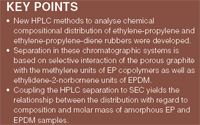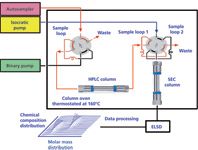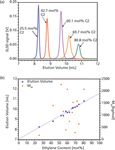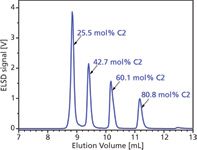Interactive Liquid Chromatography of Olefin-based Elastomers
LCGC Europe
The use of interactive liquid chromatography using porous graphite as a stationary phase and gradients of long chain alcohols and chlorinated aromatics to separate olefin-based elastomers according to their chemical composition is discussed.
The separation of olefin-based elastomers such as ethylene-propylene (EP) and ethylenepropylenediene (EPDM) rubbers according to their chemical composition cannot be achieved using techniques based on crystallization, which are widely used to fractionate semi-crystalline olefin copolymers. Interactive liquid chromatography using porous graphite as a stationary phase and gradients of long chain alcohols and chlorinated aromatics offers the possibility to separate these materials according to their chemical composition. Coupling the high performance liquid chromatography (HPLC) separation according to the chemical composition in the first dimension with size exclusion chromatography (SEC) according to the molar mass in the second dimension yields the complete molecular heterogeneity of these materials for the first time.
Ethylene-propylene-diene (EPDM) terpolymers, which consist of the three monomers: ethylene, propylene and diene, continue to be one of the most widely used synthetic rubbers for both speciality and general purpose applications. They excel with their outstanding resistance to ozone, oxidation, ageing, weather, aggressive chemicals and high temperatures (1,2). These unique features make EPDM useful for outdoor and elevated temperature applications, such as automotive profiles, singleply roofing, electrical insulation, belts, window gaskets and water seals. Dicyclopentadiene, 5-ethylidene-2-norbornene (ENB) and 5-vinyl-2-norbornene are the dienes typically incorporated in commercial EPDM. On a molecular level the application properties are influenced by the molar mass and its distribution (MMD), the chemical composition and its distribution (CCD), and the distribution of the monomers across the molar mass distribution (MMCCD). It is therefore important to study these distributions.

The MMD of polyolefins and the corresponding average values can be analysed by size exclusion chromatography (SEC). The CCD of semi-crystalline olefin copolymers is usually determined by fractionation techniques like crystallization analysis fractionation (CRYSTAF) (3) and temperature rising elution fractionation (TREF) (4). These discriminate between the polymer chains based on their crystallizability from a dilute solution in a temperature gradient and consequently fail to fractionate amorphous ethylene-propylene and EPDM samples.
HPLC could be a useful alternative to fractionation techniques considering the selectivity, speed of separation and the ability to separate amorphous samples that is achievable. However, in the case of olefin-based elastomers no suitable stationary and mobile phases were known. Applications of porous graphite as stationary phase for the liquid chromatographic separation of small molecules have been known for more than a quarter of a century and have been reviewed (5). Compared to conventional reversed phases, graphite displays superior selectivity for particular structural features like aromatic units or alkyl chains. However, this potential has never been exploited for the chromatographic fractionation of synthetic polymers.
The first application in this regard was the separation of blends of linear polyethylene, and the three stereoisomers of polypropylene using a commercially available porous graphite column as stationary phase and a gradient of 1-decanol→ 1,2,4-trichlorobenzene (TCB) as the mobile phase (6). The underlying principle is the alignment of alkanes (ethylene sequences) with their carbon skeleton parallel to the graphite surface plane. This knowledge was further extended to copolymers of ethylene and 1-olefins and it was demonstrated that the elution volume of these materials decreases with increasing incorporation of the comonomer (7–9).
Synthetic copolymers are distributed in more than one parameter (i.e., in molar mass, chemical composition and tacticity) and these distributions are mutually dependent. Therefore unravelling these heterogeneities and their mutual dependence requires the coupling of analytical techniques. Comprehensive two-dimensional chromatography (2D-LC) with high performance liquid chromatography (HPLC) coupled to size exclusion chromatography (SEC) yields information on the relationship between the chemical composition distribution and the molar mass (10,11). In this approach the samples are first separated by their chemical composition and these fractions are further analysed by SEC. Such separations were realized recently for functionalized polyolefins (12) and ethylene/1-octene copolymers (13, 14), as well as for polyolefin blends (15). In this paper we want to demonstrate how amorphous EP copolymers and EPDM terpolymers can be separated by high temperature HPLC (HT-HPLC) using porous graphite as stationary phase and how this knowledge can be used to realize a two-dimensional separation with regard to composition and molar mass.
Experimental
High-temperature HPLC (HT-HPLC): A high-temperature chromatograph PL XT-220 (Agilent Technologies, Santa Clara, California, USA) containing a robotic sample handling system PL-XTR (Agilent Technologies) for injection of the samples was used. A high-pressure binary gradient pump is a part of this chromatograph. The temperature of the sample block, the injection needle, the injection port and the transfer line between the auto sampler and the column compartment was set at 160 °C. An evaporative light-scattering detector (ELSD, model PL-ELS 1000, Agilent Technologies) was used for detection. The following parameters were used for running the ELSD: gas flow rate = 1.5 L/min, nebulizer and evaporator temperatures = 160 °C and 260 °C, respectively. The flow rate of the mobile phase was 1 mL/min. The polymers were dissolved for 2–5 h in 1-decanol at a concentration of 1–2 mg/mL and a temperature of 160 °C. 50 µL of the polymer solution was injected into the column.
A Hypercarb column (Thermo Scientific, Dreieich, Germany) containing particles of porous graphitic carbon (average particle size 5 µm, surface area 120 m2 /g, pore size 250 Å) was used. The dimensions of the column were 100 × 4.6 mm i.d.
High-temperature two-dimesional liquid chromatography (HT 2D-LC): All experiments were performed using a prototype chromatographic system for high-temperature two-dimensional liquid chromatography constructed by Polymer Char (Valencia, Spain), comprising an autosampler, two separate ovens, valves and two pumps equipped with vacuum degassers (Agilent, Waldbronn, Germany). One oven was used for thermostating the SEC column, while the second one, where the injector and a switching valve were housed, was used to thermostat the HPLC column. A scheme of the HT 2D-LC setup is shown in Figure 1.

Figure 1: Scheme of 2D-LC at high-temperature.
The HT-HPLC and HT-SEC columns were coupled by an electronically controlled eight-port valve system EC8W (VICI Valco instruments, Houston, Texas, USA) equipped with two 200 µL loops. From the moment of injection into the HPLC column (100 µL injection loop), the eight-port valve was switched every 2 min in order to inject 200 µL of effluent from the HPLC into the SEC column.
The effluent from the SEC column was monitored by an ELSD. Both ovens, the autosampler as well as the transfer line between the autosampler and the columns and the ELSD, were thermostated at 160 °C. The 2D-LC was handled by software provided by Polymer Char (Valencia, Spain). WinGPC 7.0 (Polymer Standards Service, Mainz, Germany) was used for data acquisition and evaluation.
First dimension separations were carried out on a Hypercarb column packed with porous graphite particles with the following parameters: column size 250 × 4.6 mm i.d., average particle size diameter 5 µm, surface area of 120 m2 /g and pore size of 250 Å (Thermo Scientific, Dreieich, Germany). A PL Rapide H column, 150 × 7.5 mm (Polymer Laboratories, Church Stretton, England) was used in the second dimension (SEC).
Mobile phases: 1-decanol, 2-octanol and 1,2,4-trichlorobenzene (TCB) of synthesis quality (Merck, Darmstadt, Germany) were used as the mobile phases. TCB was distilled before use and 1-decanol and 2-octanol were used as delivered.
All gradient runs in HPLC had 3 min of isocratic elution before applying a 10 min linear gradient starting with 100 vol. % of 1-decanol and ending with 100 vol. % of TCB.
In HT 2D-LC the first dimension separations were done by applying a linear gradient 1-decanol→TCB at a flow-rate of 0.1 mL/min. Starting with 100% of 1-decanol for 40 min, the volume fraction of TCB was linearly increased to 100% within 80 min and then held constant for a further 80 min. Finally, the initial chromatographic conditions were re-established. TCB was used as the mobile phase in the second dimension (SEC) with a flow rate of 2.5 mL/min.
Results and Discussion
Separation of ethylene-propylene rubbers according to chemical composition: To ensure that all polymer samples are completely dissolved, temperatures as high as 160 °C were used. The polymer solutions were injected into the porous graphite column and adsorbed from long chain alcohols (1-decanol or 2-octanol) on the column packing. The retained polymers were then desorbed after 10 min linear gradient 1-decanol or 2-octanol→TCB. The elugrams of the EP copolymers, which vary in their ethylene content, are shown in Figure 2(a).

Figure 2: (a) Overlay of chromatograms of EP copolymers. The average chemical composition (content of ethylene, C2) is indicated in the figure, and (b) correlation between the elution volume at peak maximum and the average ethylene content and weight-average molar mass (Mw). Mobile phase: gradient 1-decanolâTCB.
While the sample with the highest ethylene content (80.8 mol %) elutes at 41 vol. % of TCB in the gradient, the sample with the lowest ethylene content (25.5 mol %) elutes early at 16 vol. % of TCB. The elution volume of the samples at peak maxima increases linearly with the content of ethylene [Figure 2(b)]. At the intercepts with the compositional x-axis, the elution volume in Figure 2(b) corresponds to that of linear polyethylene having a molar mass above 20 kg/mol at 100 mol % ethylene and the elution volume at the other end (at 0 mol % of ethylene), indicates that the propylene units present in the EP samples are isotactic or atactic. No correlation exists between weight-average molar mass (Mw) and the elution volume [Figure 2(b)] suggesting that the retention is not influenced by the molar mass in the tested range of 200–2400 kg/mol.
Figure 3 illustrates the excellent baseline separation of an EP blend separating each component at a concentration of 1 mg/mL into individual components using the chromatographic system porous graphite/2-octanol→TCB. The difference in peak heights, that is, the response of the ELSD, could be attributed to its dependence on the composition of the mobile phase as well as that of the analyte (16). The increase in polarity of the alcohol (2-octanol vs. 1-decanol) leads to a stronger retention of the EP copolymers on porous graphite. These chromatographic systems allow the monitoring of the CCD of synthesized copolymer samples and the separation of different EP copolymers blends, as well as identifying homopolymers in them.

Figure 3: Overlay of chromatograms of a blend of EP copolymers at a weight ratio of 1:1:1:1. Average chemical composition (content of ethylene, C2) is indicated in the figure. Mobile phase: gradient 2-octanolâTCB.
Interactive HPLC of EPDM rubbers: The exclusive influence of ENB on the retention of EPDM samples on porous graphite is shown in Figure 4 using a set of samples which are identical with regard to their content of ethylene but vary in ENB content.

Figure 4: (a) Overlay of chromatograms of EPDM samples and (b) elution volume at peak maximum vs. ENB content. Mobile phase: gradient 1-decanolâTCB.
It can be clearly observed from these chromatograms that the elution volume increases linearly with the ENB content. While the concentration of ethylene determines the elution volume in EP copolymers (Figure 2), the content of both ethylene and ENB influence the retention of EPDM terpolymers (17). As a hypothesis we tentatively attribute the influence of the diene to either its geometrical arrangement or the unsaturation left in the incorporated ENB, which could promote adsorption via attractive interaction with the graphite.
Simultaneous characterization of CCD and MMD using 2D-LC: MMD and CCD are two molecular parameters which are of primary interest in industrial polyolefins because of their impact on the properties of the end products. Even though the individual parameters can be studied separately by HPLC and SEC, it is the mutual interrelationship between the CCD and MMD which finally determines the macroscopic properties and this comprehensive information can only be obtained by combining these two techniques, two-dimensional LC (HPLC × SEC). The SEC chromatograms of all fractions created contour plots shown in Figure 5.

Figure 5: Contour plot of a blend of three EP copolymers obtained by high-temperature 2D-LC. The average chemical composition (content of ethylene, C2) is indicated in the figure.
The x-axis in the contour plot reflects the differences in molar mass of samples. Linear polyethylene standards were used to calibrate the SEC column. The differences in the chemical composition of the separated components manifest themselves on the y-axis. The latter was calibrated using EP copolymers of narrow CCD. Figure 5 illustrates high resolution power of the presented 2D-LC. All the injected components are baseline separated by HPLC. The run time for such 2D-LC analysis is 4–6 h for each sample, including sample preparation. Such a characterization is not possible using any conventional analytical methods.
Conclusions
Although porous graphite has been used for almost 30 years in liquid chromatography, it was not applied to separate synthetic polymers until recently (6–9, 12–14, 17). A chromatographic system which could separate amorphous polyolefins, such as ethylene-propylene copolymers and EPDM terpolymers, according to their chemical composition was also not known for years. The results presented in this paper illustrate the successful application of the porous graphite for the separation of EP and EPDM samples. Selective adsorption and desorption of the polymers is the underlying principle of this separation on porous graphite as stationary phase. This sorbent selectively interacts with the methylene units of EP copolymers as well as ethylidene-2-norbornene units present in EPDM. While methylene units influence the separation of EP copolymers, both methylene as well as ENB units influence the separation in the case of EPDM. Coupling the HPLC separation to SEC offers for the first time access to the full molecular heterogeneity, that is, the relationship between the distribution with regard to composition and molar mass of amorphous EP and EPDM samples.
These innovative results can be extremely helpful for researchers to develop process—structure—property relationships and to understand the influence of process parameters on the structure of the resulting polymer materials. Moreover, they may inspire analytical chemists to test the separation of other synthetic or natural macromolecular materials using porous graphite.
Acknowledgements
This work is part of the research programme of the Dutch Polymer Institute (DPI) under the Project # 642/643. Support by the Deutsche Forschungsgemeinschaft, DFG, (project No. MA 4348/1-1) is gratefully acknowledged.
Rajesh Chitta and Anton Ginzburg are PhD students at the German Institute of Polymers (DKI, Darmstadt, Germany) and are involved in developing liquid chromatographic techniques for the analysis of polyolefins.
Tibor Macko is a researcher at DKI, Darmstadt, Germany.
Robert Brüll is deputy head of the department of chemical analysis in DKI, Darmstadt, Germany.
Gerard van Doremaele is director of process and catalyst development at Lanxess Elastomers, Geleen, The Netherlands.
References
(1) W. Hofmann, in Rubber Technology Handbook (Hanser Publishers, Munich, 1989).
(2) R.D. Allen, J. Elastom.Plast. 15(1), 19–32 (1983).
(3) B. Monrabal, in Encyclopedia of Analytical Chemistry, R. A. Meyers, Ed. (Wiley, New York, 2000), 8074.
(4) L. Wild and G. Glöckner, Adv. Polym. Sci. 98, 1–47 (1991).
(5) L. Pereira, J. Liq. Chromatogr. Related Technol. 31(11–12), 1687–1731 (2008).
(6) T. Macko and H. Pasch, Macromolecules 42(16), 6063–6067 (2009).
(7) T. Macko, R. Brüll, R.G. Alamo, Y. Thomann and V. Grumel, Polymer 50(23), 5443–5448 (2009).
(8) M.D. Miller, A.W. deGroot, J.W. Lyons, F.A. Van Damme and B.L. Winniford, J. Appl. Polym. Sci. 123(2), 1238–1244 (2012).
(9) R. Chitta, T. Macko, R. Brüll and G. Kalies, J. Chromatogr. A 1217(49), 7717–7722 (2010).
(10) D. Berek, Progr. Polym. Sci . 25(7), 873–908 (2000).
(11) M. Kivilompolo, J. Pol and T. Hyötyläinen, LCGC Europe 24(5), 232–243 (2011).
(12) A. Ginzburg, T. Macko, V. Dolle and R. Brüll, J. Chromatogr. A 1217(44), 6867–6874 (2010).
(13) A. Roy, M.D. Miller, D.M. Meunier, A.W. deGroot, W.L. Winniford, F.A. van Damme, R.J. Pell and J.W. Lyons, Macromolecules 43(8), 3710–3720 (2010).
(14) D. Lee, M.D. Miller, D.M. Meunier, J.W. Lyons, J.M. Bonner, R.J. Pell, C. Li Pi Chan and T. Huang, J. Chromatogr. A 1218(40), 7173–7179 (2011).
(15) A. Ginzburg, T. Macko, V. Dolle and R. Brüll, Eur. Polym. J. 47(3), 319–329 (2011).
(16) A. Albrecht, R. Brüll, T. Macko and H. Pasch, Macromolecules 40(15), 5545–5551 (2007).
(17) R. Chitta, T. Macko, R. Brüll, G. van Doremaele and L.C. Heinz, J. Polym. Sci., Part A: Polym. Chem. 49(8), 1840–1846 (2011).
Polysorbate Quantification and Degradation Analysis via LC and Charged Aerosol Detection
April 9th 2025Scientists from ThermoFisher Scientific published a review article in the Journal of Chromatography A that provided an overview of HPLC analysis using charged aerosol detection can help with polysorbate quantification.
Removing Double-Stranded RNA Impurities Using Chromatography
April 8th 2025Researchers from Agency for Science, Technology and Research in Singapore recently published a review article exploring how chromatography can be used to remove double-stranded RNA impurities during mRNA therapeutics production.









